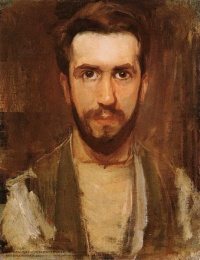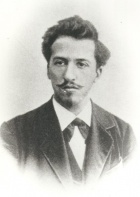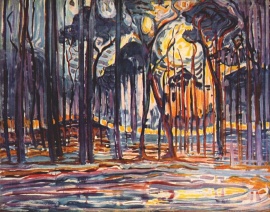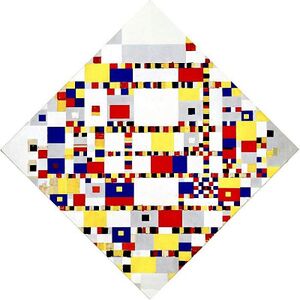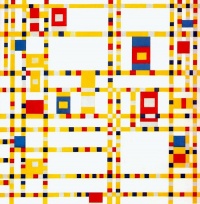Piet Mondrian
UNDER CONSTRUCTION
UNDER CONSTRUCTION
Pieter Cornelis "Piet" Mondrian (March 7, 1872 – February 1, 1944), was an influential Dutch painter, and one of the founders of the Dutch modern movement De Stijl.
Early life and education
Piet Mondrian was born on March 7, 1872 in the Dutch town of Amersfoort. His father and uncle taught him to draw and paint.
His artistic talent was fostered by his father, a confirmed Calvinist and a schoolmaster, with whom the young Mondrian collaborated in a series of historical paintings with a moralizing aim. In spite of this initial support, Mondrian was confronted with harsh opposition form his family when he decided to give up his career as an art professor and devote himself entirely to painting. In 1892, Mondrian enrolled at the Academy of Fine Arts in Amsterdam and entered that city's artistic circles. During the same period, he came into contact for the first time with esotericism, most notably with Theosophy, which would lead to his gradual estrangement from the Calvinist faith.[1]
Artistic career
Mondrian was first employed as a primary school teacher, and also painted naturalistic landscapes. His early works employed soft, misty colors of the Dutch countryside, but around 1907 his palette expanded into stronger color schemes.
Transition away from naturalism
Woods Near Oele, painted in 1908, is representative of Mondrian's move toward abstraction.
This large canvas, whose subject has been identified... as the woods near the village of Oele... marks a milestone in the painter's work. It shows the phase of his art in which his horizon opened up and he began to look beyond the somewhat narrow boundaries of the Dutch school...
The painting itself is clearly a transitional work. On the one hand it belongs... to a period in which a scene of nature is brought to sober, almost solemn simplicity by means of rigorous stylization and stringent two-dimensional treatment. On the other hand, the color, the brushwork, and the rhythm of the painting betray a dynamism that indicates foreign influences...
The new view of reality, the realization that there are forces existing in nature related to those of human feeling and thought, stimulated Mondrian to attempt a fresh approach.[2]
The artist explored artistic styles like Luminism (also called Divisionism) and Symbolism, but in 1911 was drawn to the Cubism of Picasso and Braque. "Mondrian developed his own individual notion of Synthetic Cubism, exhibiting a definite tendency toward full abstraction."[3] He radically simplified the elements of his paintings to reflect what he saw as the spiritual order underlying the visible world, creating a clear, universal aesthetic language within his canvases.
De Stijl and Neoplasticism
De Stijl developed as an artistic and architectural movement in The Netherlands, from about 1917 to 1931. The artists aimed for pure abstraction rather than representation. They reduced the color palette to black, white, gray, and primary colors. Mondrian developed a form that he called neoplasticism, in horizontal and vertical configurations.
He also evolved a non-representational form that he termed neoplasticism, which consisted of white ground, upon which he painted a grid of vertical and horizontal black lines and the three primary colors.
New York years
When World War II broke out, Mondrian left Europe to take up residence in New York City. He loved the city - particularly its architecture and its modern music. His final two paintings celebrated the pulsing rhythms of jazz. In Broadway Boogie-Woogie, the artist moved away from outlining the colored spaces with black, giving a more open effect. Small segments of colors were distributed in patterns evoking syncopation or staccato. Victory Boogie-Woogie was not quite completed when the artist died, but it framed the horizontal and vertical lines in a rhombus or "lozenge" shape.
Theosophical Society involvement
In 1908 Piet Mondrian became interested in the Theosophical Society. Its founder, Blavatsky believed that it was possible to attain a knowledge of nature more profound than that provided by empirical means, and much of Mondrian's work for the rest of his life was inspired by his search for that spiritual knowledge.
Later years
Published collections and exhibit catalogs
- Plastic Art and Pure Plastic Art, 1937, and Other Essays, 1941-1943. New York: Wittenborn and Co., 1945.
Other Resources
- Bax, Marty. "'Character Is Destiny' - Piet Mondrian and his horoscope." Bax Art Concepts & Services blog. March 7, 2013. Available at Baxpress.blogspot. Viewed October 21, 2016.
- Bax, Marty. "The Victory Boogie Woogie - a corpse dissected." Bax Art Concepts & Services blog. April 4, 2012. Baxpress.blogspot. Viewed October 21, 2016.
- Bris-Marino, "The influence of Theosophy on Mondrian’s neoplastic work" "La influencia de la teosofía sobre la obra neoplástica de Mondrian".
- The Union Index of Theosophical Periodicals lists 2 articles about Mondrian.
- Harris, Philip S. "Mondrian, Piet." Theosophical Encyclopedia (Quezon City, Philippines: Theosophical Publishing House, 2006), 542-543. Available at Theosopedia.
- Welsh, Robert P. "Mondrian and Theosophy – Part one." Theosophy Forward. September 27 2012. Viewed October 21, 2016.
- Welsh, Robert P. "Mondrian and Theosophy – Part two." Theosophy Forward December 10, 2010. Viewed October 21, 2016.
- Hall, Kathleen. "Theosophy and the Emergence of Modern Abstract Art" The Quest 90.3 (May-June 2002).
Notes
- ↑ José Marίa Faerna, General Editor. Great Modern Masters: Mondrian (New York: Harry N. Abrams, Inc., 1997), 7.
- ↑ Piet-Mondrian.org.
- ↑ José Marίa Faerna, General Editor. Great Modern Masters: Mondrian (New York: Harry N. Abrams, Inc., 1997), 7.
